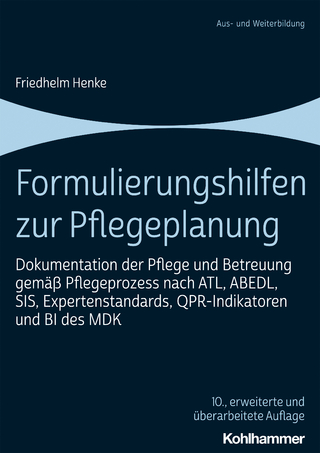
5 Easy Steps to Prevent Falls
American Nurses Publishing (Verlag)
978-1-55810-567-6 (ISBN)
Despite new approaches, education and increased focus on preventative measures, patients are still falling. The facts are undeniable: up to 50% of hospitalized patients are at risk for falls, and almost half of those who fall suffer an injury. Falls not only impact patients, they also directly affect an organization’s cost per case. The average hospital stay for patients who fall is 12.3 days longer for those who don’t, and injuries from falls lead to a 61 percent increase in patient-care costs.
5 Easy Steps to Prevent Falls: a must-have, comprehensive, user-friendly guide for all practicing nurses working in hospitals, long-term care or other health care organizations. Complete with colour photographs that highlight high-risk areas for falls and injury potential along with educational tips on how nurses can prevent falls and teach patients to do so as well, this book is divided into five easy-to-read chapters. It breaks down how to elicit those critical elements necessary to reduce and/or prevent patient falls across the care continuum. You will learn how to assess at-risk patients and those who have recently fallen through various tried-and-true techniques, assessment tools and teaching strategies, including how to:
Determine the what-when-where-and-why the fall occurred based on current science.
Identify key symptoms associated with preventable falls and medical emergencies.
Safely administer basic tests of gait and balance.
Recognize and assess patients for orthostatic hypotension.
Identify early signs of post-fall injuries (including head injuries).
Visualize firsthand high-risk environmental hazards causing falls and how to make them safe for patients.
Gain insight on teaching techniques to optimize patient skill about falls prevention.
Chock-full of evidence-based practice suggestions related to the primary and secondary prevention of falls, web-based resources, national clinical practice guidelines, clinical tips and special considerations for unique populations. This useful guide also illustrates how to effectively communicate and educate patients using the teach-back method.
Deanna Gray-Miceli, PhD, GNP, FAANP, FAAN is assistant professor at Rutgers University School of Nursing, Newark, New Jersey, and adjunct assistant professor, University of Pennsylvania School of Nursing. Dr. Gray-Miceli is a clinical scholar and national falls prevention expert whose main focus is on the development and testing of a comprehensive post-fall assessment for RNs to use in practice, which is called the Post Fall Index (PFI). Shown to be effective in reducing falls, the PFI aids professional nurses as a decision support tool to help determine why the fall occurred in the first place.
A Public Health Perspective and Background
Information on Falls and Falls Prevention
A Public Health Approach to Falls and Fall-Related Injury Prevention
Significance of Falls in America
Levels of Prevention
Where People Fall: Place of Occurrence
Falls and Fall-related Injuries among Older Adults
Language and Terms Used to Describe Falls within Public Health
Case Definitions of Falls by National Organizations
Risk to Fall and Risk to Injure: Use of Fall Risk Screening Tools
Modifiable or Potentially Reversible Fall Risk Factors
Fall Injury Reduction
Injury Severity
Preventing Injurious Falls
Measuring Falls
Mechanisms for Patient Falls within Healthcare Facilities
Types of Patient Falls
References
Step 1. Eliciting a Fall-Focused Health History
Broad Public Health Service Objective
Educational Learner Outcomes
References
Step 2. Conducting a Fall-Focused Physical Assessment
Broad Public Health Service Objective: Monitor Health Status to Identify and Solve Community Problems
Vital Signs
Visual Acuity
Cardiovascular Assessment
Pulmonary System
Gastrointestinal System
Musculoskeletal System
Other Considerations
Assessment of Functional Reach by Trained Occupational and Physical Therapists
Inspection for Suspected Post-Fall Injury
Useful Screening Measures
References and Resources
Step 3. Detecting Environmental Hazards and Modifying
the Environment for Patient and Healthcare Worker Safety
Broad Public Health Service Objective: Assuring a Competent
Workforce by Diagnosing and Investigating Health Problems in the Community
Falls at Home: The Community Setting
Hospital and Long-Term Care Setting
Falls in the Environment
Equipment
Environmental Safety (Outdoors and at Home)
Environmental Safety Checklist in the Home
Roles and Responsibilities of Nurses and Other Interdisciplinary
Team Members in Falls and Injury Prevention
Environmental Rounds in the Healthcare Setting
Environmental Modifications for Patients at High Risk to Injure
References and Resources
Five Easy Steps to Prevent Falls:
The Comprehensive Guide to Keeping Patients of All Ages Safe
Step 4. Diagnosing and Communicating the Fall Type
and Developing an Interprofessional Plan of Care
Broad Public Health Service Objectives: Three Community-based Objectives
Integrating the Historical Data, Physical Examination Findings and Environmental Assessment
Effective Communication and Handoff for Falls Prevention
Team STEPPS: Strategies and Tools to Enhance Performance and Patient Safety
Handoffs
Signage
Walking Rounds
Patient and Environmental Safety Checks
Teamwork, Fall Champions, and Promoting a Culture of Safety
Falls Management Plan
References
Step 5. Informing, Educating, and Empowering Patients
Broad Public Health Service Objective: Inform, Educate and Empower People
Core Ingredients of the Teaching Plan
Use of Teach-Backs for Falls Prevention Education
References
Index
| Erscheinungsdatum | 19.09.2018 |
|---|---|
| Verlagsort | Washington, DC |
| Sprache | englisch |
| Maße | 152 x 229 mm |
| Themenwelt | Medizin / Pharmazie ► Pflege ► Pflegemanagement / Qualität / Recht |
| ISBN-10 | 1-55810-567-0 / 1558105670 |
| ISBN-13 | 978-1-55810-567-6 / 9781558105676 |
| Zustand | Neuware |
| Haben Sie eine Frage zum Produkt? |
aus dem Bereich


